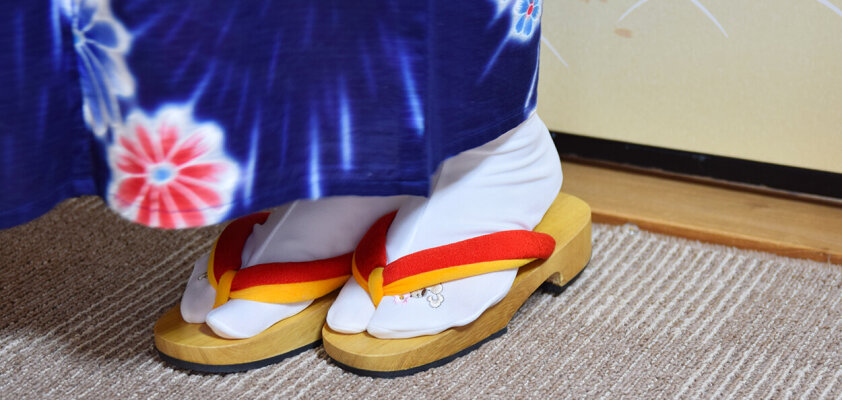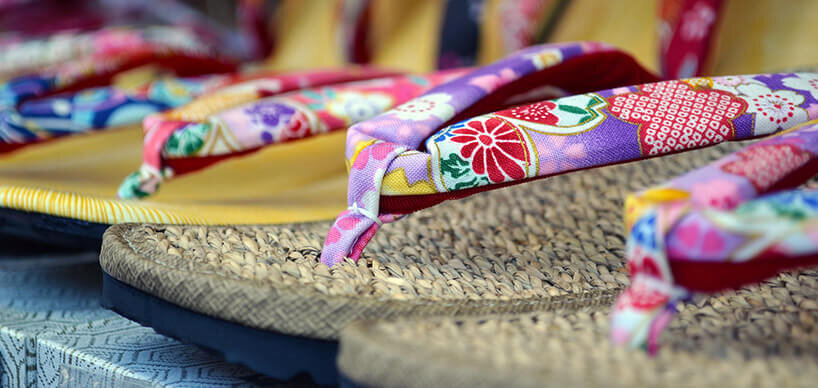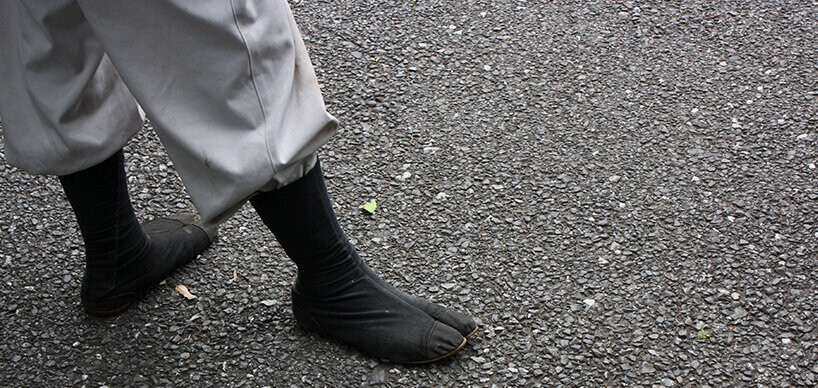Toe Socks from Japan - Tabi

Photo credits blog post cover picture: Author: Raita Futo | Flickr | License
Special type of foot cover
What completes a kimono? A beautiful hairstyle, suitable accessories – and shoes. Traditionally in Japan, they are sandals. The simple version is called Zori, woven from bamboo, but today they are also made from fabric or plastic. These are work sandals, but they also go well with various martial arts. For more formal costumes, on the other hand, wooden Geta with a higher heel are worn.

When you look at the feet of the Japanese in these sandals, you'll always see matching socks as well. These are usually plain, well-cut, and ankle-high. The tighter, the better – a snug-fitting garment is part of Japanese aesthetics. The socks also have a special feature: To be worn optimally with sandals, the big toe is separated from the others. Such toe socks are called Tabi. What may seem unfamiliar or uncomfortable to us holds many benefits for health and has a long tradition. The story of Japanese toe socks is still not fully told even today.
Which socks are for whom?
In the 15th century, Japan opened trade with China, allowing, among other things, the import of cotton, which was previously scarce in the Land of the Rising Sun. Mass production gradually developed: Initially, only the wealthy could afford cotton socks, but by the 16th century, people from all walks of life – from farmers to nobility – were wearing them.
Traditional Tabi socks are made of a firmer material than ordinary socks and are closed at the back with two, three, or four fasteners. There is also a variant that is tied at the front. Although older, this category is often worn for informal occasions. Today, stretchable Tabi without fasteners, made of latex and elastane, are most common.
Unlike the rest of the clothing, there is generally no distinction between Tabi socks for women and men. However, color still traditionally holds significance today: When Tabi became affordable for everyone, blue was worn by the common people. White was reserved for official occasions such as tea ceremonies and weddings. Samurai, as a higher class, were allowed to wear any colors and patterns, as were entertainers who, fittingly for their profession, wore colorful toe socks with vibrant patterns. Only the colors purple and gold were reserved for nobility. Samurai could also equip their Tabi with iron as part of their armor, both on the sole and around the exterior, ensuring optimal protection.
Today, this traditional footwear is mainly found in martial arts such as Ninjutsu and in very formal costumes. Casual variations, made of cotton for example, are favorites for everyday wear or informal kimonos – or as comfortable accessories for everyday life at home.
Toe socks have evolution
Tabi are now available for purchase in all imaginable categories and patterns, catering to tourists and fans of pop culture alike – from solid-colored models to traditional motifs and even colorful anime scenes, everything is possible. This fixation on socks in Japanese society stems from the fact that shoes must always be taken off when entering a house – hence, socks are seen much more frequently here than in other cultures. So, a good impression always includes beautiful, well-kept socks as part of an outfit. Additionally, it is considered very impolite to walk barefoot on Tatami mats, which are traditionally used to cover the floors of Japanese houses. Cotton soles are suitable for this purpose, as they protect the delicate mats.

Picture credits: Author: istolethetvFlickrLicense
For special purposes, there are also toe shoes: High Tabi made of leather, cotton, or plastic. Typically, these have a sturdy rubber sole and are called Jika Tabi. They emerged around the turn of the 20th century when rubber became a mass-produced material. These toe shoes, like socks, envelop the foot and ankle, and are closed at the back with hooks. They provide great flexibility, silence, a sense of the ground, a firm grip, and protection. They are often used in martial arts, earning them the nickname "Ninja Tabi." However, even today, construction workers, farmers, and gardeners, for example, still prefer wearing these shoes. It's also practical that you can hold things between the toes with such Tabi, freeing up your hands. For rice fields and damp or muddy workspaces, Tabi made entirely of rubber are particularly suitable.
Tabi conquer the world - and a little bit more
Still not satisfied? How about Tabi slippers, sneakers, or boots? There were quite a few who were inspired by the interesting look of toe socks. The Japanese shoe manufacturer Onitsuka, now known as Asics, was the first to produce sneakers with toe separation. They even brought significant success to one of their wearers: In 1951, Japanese runner Shigeki Tanaka won the Boston Marathon – wearing Tabi sneakers. Sports and outdoor companies like Nike in the USA attempted to jump on the Tabi trend. Initially, the success was limited, likely due to the post-World War II sentiment towards Japan.
Nevertheless, the trend has persisted – at least in Europe. Belgian fashion designer Martin Margiela designed his famous boots with toe separation in the 80s, inspired by Japanese fashion. Galliano is selling Tabi stilettos in this year's spring collection. And what about Asics today? They manufacture special shoes for astronauts at the Japan Aerospace Exploration Agency (JAXA). So, soon, Tabi will also be in space.
Meanwhile, Spaniards have come up with an even more extreme version of toe socks: a version for all five toes, called Fivefingers. They are said to stimulate circulation and prevent inflammation, especially when used for sports. Unfortunately, these socks have not proven very popular in Japan. This is probably because toe lengths are an individual matter, and nobody wants to restrict their toes. However, rubber shoes for all five toes, such as those from the company Vibram, are still popular in Europe.
Why wear tabi?
Even if you don't plan on running a marathon or becoming an astronaut, there are good reasons to wear Tabi, especially the firmer variety. You are doing something good for your health: The altered surface provides more stability and balance. The thick sole trains the foot muscles, simultaneously massaging the feet and stimulating reflex zones directly connected to the brain. This connection is particularly attributed to the big toe. Since it is not restricted, less pressure is exerted on the feet. After all, they have to carry the entire body, and good foot posture translates to the spine, which is essential for a healthy back.
Whether you wear toe socks for sports, leisure, or special occasions and costumes – Tabi socks enrich every wardrobe and benefit your feet. Perhaps you'll think about their incredible history the next time you come across this amusing footwear. Who would have thought that socks could be so fascinating?
You may also be interested in our article on Japanese kimono:











-from-the-yakiyaki-grill-pan.jpg)




